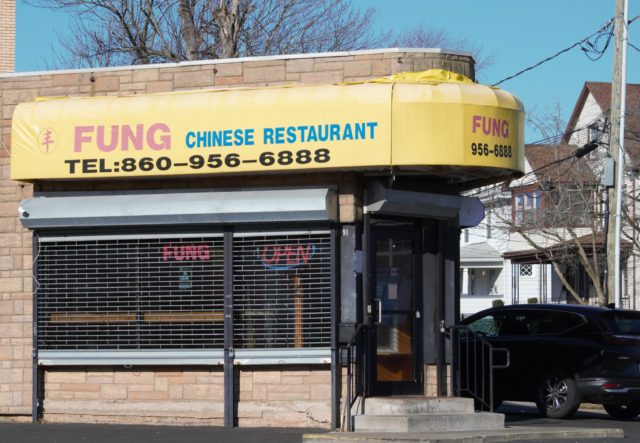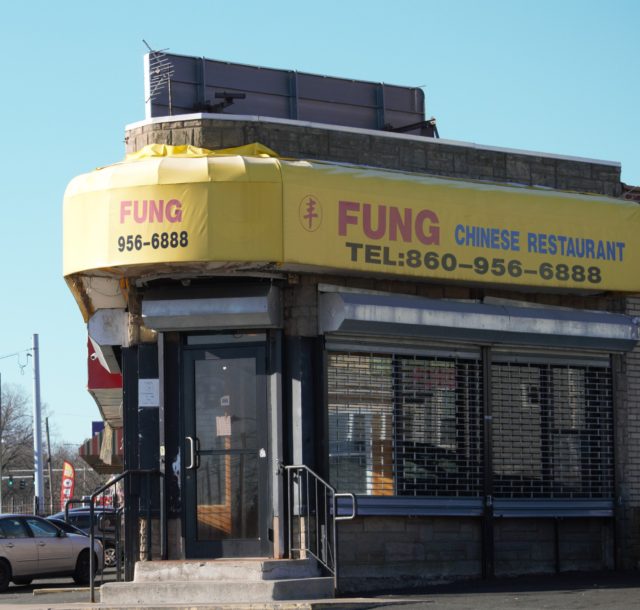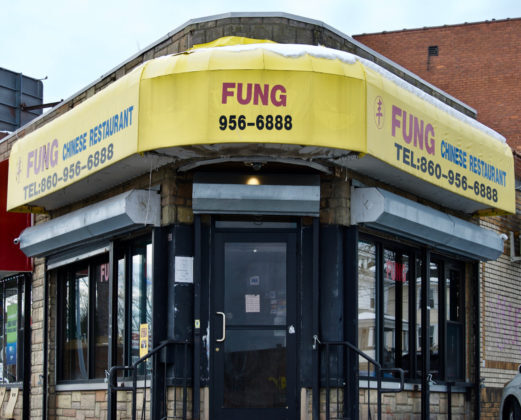This post is about Fung and it is not about Fung. It’s what makes Fung Chinese Restaurant possible, and what threatens it, and others like it.
This year, we celebrate 123 years of Chinese restaurants in Hartford.
When “The Sign of the Yellow Dragon,” as the Hartford Courant called it, opened in February 1898 at 184 State Street, the city’s first Chinese restaurant was regarded by the paper as “[a]nother evidence that Hartford has become a metropolis.”
Two cooks were employed, one designated for preparing only American dishes at what was billed in ads as a “Chinese and American restaurant,” with meals served from 9 AM through 2 AM. Is there any restaurant serving food at that hour in Hartford today?
Within months, the restaurant lost its cook who specialized in Chinese dishes, and the owner decided to call it quits. By September of that same year, a new owner took over and renamed the establishment: Wah Hop Cafe. This was announced before a new Chinese chef had been hired.
Ten years before Hartford (the “metropolis”) would see one Chinese restaurant, there were already several in New York City. According to Time magazine the Canton Restaurant in San Francisco was the first of its kind to open in the United States; that was in 1849. Considering how gloriously plentiful Chinese restaurants are today, it feels like the cuisine took awhile to catch on.
When I originally began writing this piece back in February, I had been talking with an Asian American friend who was expressing concern about the safety of her elderly parents. Newly vaccinated, they were excited to begin getting out and about, while she was worried about what would happen to them in public.
During 2020, there was a dramatic increase in hate crimes against Asian Americans, with elders and women being singled out in particular. Though the former administration’s head stoked this bigotry through his repeated use of hateful rhetoric in which he equated Covid-19 with China, he did not create this brand of racism.
Here in Hartford, during the 19th century we would see the newspaper on more than one occasion use the term “wily” to describe a Chinese person — and trust, there was no context to justify it. When the Geary Act required registration and photographic identification of Chinese residents, the newspaper chose to publish the names and addresses of those residents. This record tells us that around the 100 Chinese who registered in Hartford in 1894, some lived on Mulberry Street, Flower Street, and at the corner of Park and Lawrence Streets, among other places. What function this served at the time, I do not know, but the Geary Act was not a standalone insult.

The Chinese Exclusion Act (1882) had already banned immigration of Chinese laborers, and this remained in place until 1943. That’s not because the United States had a major change of heart; the Chinese were allies in WWII, and it would’ve looked petty to keep up such a ban. Still, immigration was strictly limited to only 105 people per year for about the next decade.
As if the Chinese Exclusion Act and its extension, the Geary Act, were not gross enough on the surface, these and other laws restricted rights in numerous other ways. There was no opportunity for the Chinese already here to become naturalized citizens; this was conveniently codified in 1870, just after the transcontinental railroad was completed, just after the United States had successfully extracted labor from immigrants who would now not receive the courtesy of protections afforded through citizenship.
Also in 1870, and this is especially relevant to the recent spates of domestic terrorism, Chinese and Japanese women were not permitted to enter the United States unless their husbands or fiancées vouched for their moral character. Five years later, the Page Act declared that women from East Asian countries were forbidden to be “imported” to the United States for the purpose of prostitution. Basically, what this tells us is that women coming for a particular part of the world were assumed to be sex workers, and the burden was on them to prove otherwise.
When an armed man goes on a shooting spree in 2021 causing numerous deaths — primarily women of Asian descent — it requires no imagination to see how our history, nevermind the culture at large, has played a role in his decision to target this population. There are those who fetishize Asian women (whether those women are employed in the sex industry or not) and this objectification is what enables an angry man with a gun to do what angry men with guns have been allowed to do in this country.
See, when I started this piece, I wanted to just write about what it was like for Hartford to get its first Chinese restaurant, because that must have been a big deal at the time. Yet, I can’t separate that from this.
Shortly after Hartford was declared a metropolis, the Brooklyn Eagle (Brooklyn, NY, not Brooklyn, CT) in 1901 publishes this whole piece about how Americans can enjoy Chinese “cookery.” The Hartford Courant reprints it, though at this time it seems there was only still the one Chinese restaurant on State Street. By then, this “decided fad in Greater New York” has resulted in hundreds of restaurants within New York, with the uptown ones catering “exclusively to white people.” It’s noted that the dish favored in those establishments is Chop Suey.
Though there is an attempt by the author to make more accessible to white diners’ palates Chinese cuisine by dispelling myths (“People who go to a Chinese restaurant for the first time are usually in great fear they will be surreptitiously served with rat stew, fried cat, fricasseed dog, or some other delicacy of a kind supposed to be peculiarly Chinese, They need not worry”), the result is a mix of stereotyping and exoticization. Diners are warned to act with decorum or else they may be overcharged, and it’s specifically noted that the restaurant owners hate, in particular, “talky, giggly girls.”
Chopsticks are described in great detail.
That’s after an 1894 article is published in the Courant marking the opening of the first Chinese restaurant in Washington DC. In this, there is a long discussion of chopsticks that concludes: “the best way is to submit to using a plain American knife and fork.”
It’s as if with these stereotypes, time froze.
In April 2021, the New York Times published a list of reported anti-Asian incidents ranging from hateful comments to vandalism to personal violence. Restaurant owners were threatened in Seymour, Connecticut. An Albuquerque, New Mexico restaurant was defaced, with the message: “watch out for the coronavirus.” In Manhattan, someone scrawled “stop eating dogs” across a restaurant window. “COVID-19” was among several messages spray painted on a restaurant in Wyckoff, New Jersey. In Elk Grove, California, a man (who was arrested) painted an anti-Asian ethnic slur and dumped garbage across the front of a restaurant. In March 2021, someone spray painted various slurs and hateful messages on a restaurant in San Antonio, Texas after its owner criticized the governor for prematurely lifting the mask mandate. This is only what was reported.
It’s no effort to feel incensed by the wrongs from decades ago, but this ignorance remains fresh. The old attitudes persist, as we are seeing.

Hartford in 1901 has a Chinese restaurant on the second floor of 126 State Street, a building described as previously serving as a mansion. The newspaper decides to feature it in an article about the growing number of places where a person can buy a meal in the middle of the night. What one learns from this is less about the food and more about what the Courant deemed acceptable to publish at the time. In between the generalizations its author makes about the Chinese, he mocks the waiter’s accent, and describes the restaurant’s workers as “men who never read the newspapers, who couldn’t tell a Mississippi lynching from a maple-sugar bee” and “who have no women to furnish them with light gossip or manufacture it for them.” It ends with one of the employees referring to an American-Chinese dictionary, so he can try to communicate with this fool of a newspaper writer.
Only a few years later, the paper publishes a piece with a headline reading “Waitress Marries [racial slur].” This wasn’t just fringe publications disseminating rude and hateful material: it was the country’s oldest, continuous publication.
Other Chinese restaurants begin to emerge in Downtown, but often the newspaper’s coverage of them has nothing to do with food. Shanghai Restaurant on the 100 block of State Street only garnered the media’s attention when there were problems associated with blocked and locked fire escapes in 1914, along with opium charges. . . and the headlines played right into moral panic, pointing out how “WHITE WOMEN FOUND” during the raid. The Hartford Courant pandered to lurid curiosity, coming back to the “good-looking blond, about 30 years old, who had once been handsome.” It got press again during future raids, but never for its food.
Meanwhile, in 1915, The Canton opens at 257 Asylum Street with the newspaper publishing a passive aggressive note of how “Hartford is promised a first-class Chinese restaurant.” At this time, there is also a Chinese restaurant on Main Street, which is known because four men were arrested there on breach of peace charges “as the outcome of an alleged attempt to flirt with a waitress, a white woman.” What their cuisine was like, who can know?
In 1917, just as all Asians became prohibited from immigrating to the United States, the Far East Garden, serving American and Chinese cuisine, opens with fanfare at 76 State Street, the site of a former bank.
A few years later, the newspaper takes note of how chopsticks are used at The Chinese Merchants Association’s New Year’s banquet, proving that Hartford was as obsessed in 1922 as it was in 1894 with chopsticks.
On January 26, 2021 — less than one week after taking office, President Biden signed an executive order condemning racism against Asian Americans and Pacific Islanders: “The Federal Government must recognize that it has played a role in furthering these xenophobic sentiments through the actions of political leaders, including references to the COVID-19 pandemic by the geographic location of its origins. Such statements have stoked unfounded fears and perpetuated stigma [that has] contributed to increasing rates of bullying, harassment, and hate crimes against AAPI persons.”
This comes after Connecticut’s governor and other leaders spent parts of the last year trying to convince the public that Chinese food was safe to eat.
Supporting your local Chinese restaurants is not going to solve the problem of anti-Asian attacks, but damn if it’s not the least we can do.
Fung Chinese Restaurant is located at 891 Maple Avenue.
In the comments, let us know your favorite(s) that are either in Hartford or that will deliver to Hartford.
Unhidden Gems is a series published every other Monday, spotlighting one of Hartford’s treasures that sits right out in plain sight. These are restaurants, clubs, cultural centers, and other places that are either on or easily visible from one of Hartford’s main streets.

Jennifer Sharp
In the 1920 Hartford City Directory, there were 18 laundries listed (p. 1296), followed by 39 “Chinese laundries.” Those 39 business owners were not eligible to vote. They employed people like Lizzie Thornton Jackson (https://hplct.libguides.com/October1920/extras/georgia), however, who registered that October.
Kerri Provost
Thanks for sharing this!
Richard Nelson
Thanks for this history and thanks to Jennifer for adding to it. (opening up new exciting places to study) When I first came to Hartford in 1978 I worked as the dishwasher at Song Hays on Asylum St. downtown. It was wonderful to work there and respectfully loved George and his family that ran the place. Every night Mamma would cook all of the workers a meal. Once when I fell asleep standing at the dish machine, the dishes began to pile up, Mamma came over and helped me. Her and I use to laugh about that for a long time. My friend Chan, who I am still in touch with after all these years, and I use to go around and visit the art shows in town. I think it was one of the few business downtown that in the early morning Mamma would come out and wash the sidewalk in front of the restaurant. Wonderful memories and wonderful times.